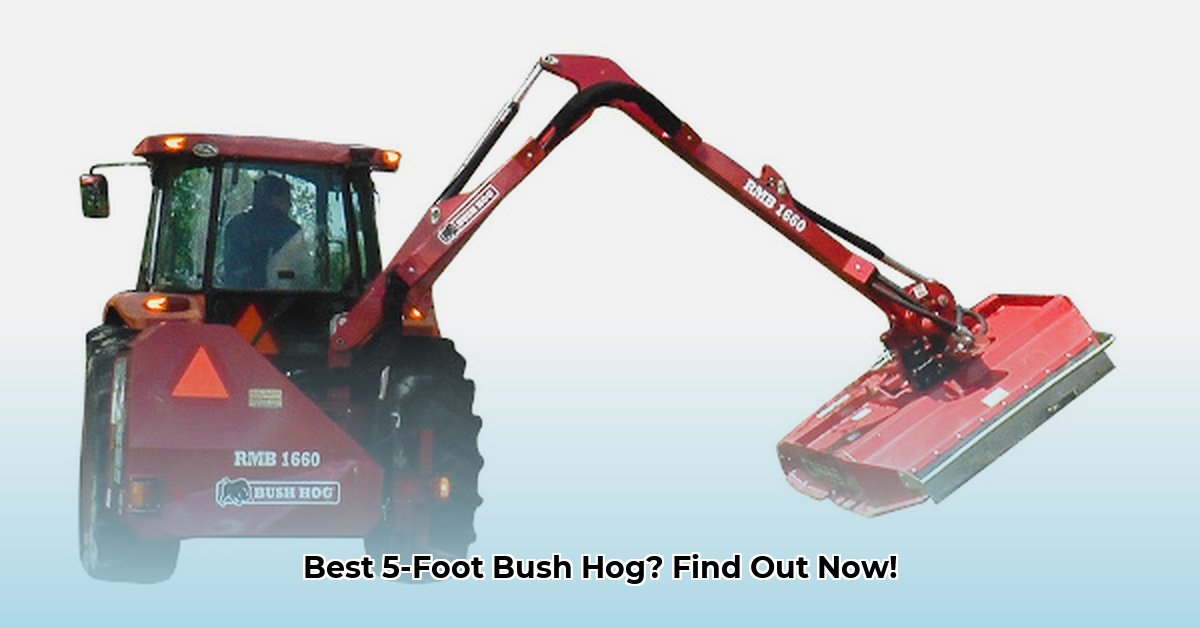
Tractor Supply 5-Foot Bush Hog: Your Guide to a Smart Purchase
Considering a used Tractor Supply 5-foot Bush Hog rotary cutter? This guide helps you navigate the process, from finding the right machine to ensuring its long-term performance. We’ll cover crucial inspection points, price negotiation strategies, and essential maintenance practices. Whether you're a seasoned farmer or a newcomer to land management, this guide provides actionable steps for a successful purchase and sustainable land care. For more on tractor attachments, check out this helpful resource.
Understanding the Used Rotary Cutter Market
The market for used rotary cutters is dynamic, with prices varying significantly. You might find a 5-foot Bush Hog ranging from $500 to $1500. Several factors influence these price fluctuations: the machine's condition, its location (affecting shipping costs), and the seller's motivation. A reputable brand like Bush Hog typically commands a higher price due to its perceived reliability and resale value.
Key Factors Affecting Used Rotary Cutter Prices:
- Brand Recognition: Established brands like Bush Hog often fetch higher prices.
- Overall Condition: A well-maintained cutter will cost more than a heavily used one.
- Geographic Location: Shipping costs can significantly impact the total price.
- Seller Motivation: A seller eager to offload a cutter might be more flexible in negotiations.
Before You Buy: A Thorough Inspection Checklist
A pre-purchase inspection is paramount. This isn't just about finding faults – it's about understanding the true value and negotiating a fair price.
Blade Inspection: Examine the blades for sharpness, bends, or breaks. Damaged blades are a major red flag and could lead to costly repairs.
Gearbox Examination: Check the gearbox for leaks or damage. Gearbox issues are expensive to fix; thorough inspection is vital.
PTO Shaft Assessment: Carefully examine the PTO (power take-off) shaft for bends or damage. A damaged PTO shaft presents both a safety and repair cost risk.
Overall Condition: Look for rust, dents, or signs of neglect. A well-maintained machine suggests lower future maintenance costs. Is the paint faded or chipped? Does it appear to have been recently serviced?
Isn't thorough inspection worth the time? A pre-purchase inspection can save you money and headaches later.
What Drives the Price of a Used Tractor Supply 5-Foot Bush Hog?
Pricing is influenced by a multitude of factors. Understanding these variables empowers you to negotiate effectively.
Brand Reputation: Established brands often command higher prices.
Equipment Condition: The level of wear and tear significantly impacts the price.
Shipping Costs: Distance from seller to buyer directly affects total expenses.
Seller's Urgency: Motivated sellers may be more open to negotiation.
Knowing these factors will allow you to confidently make your purchase.
Weighing the Pros and Cons: Is a Used Rotary Cutter Right for You?
Buying used offers significant upfront savings, but remember the potential for repairs.
Pros:
- Substantial Cost Savings: Used equipment is typically much cheaper than new.
- Comparable Performance: A well-maintained used cutter can function as effectively as a new one.
Cons:
- Unexpected Repair Costs: Be prepared for potential maintenance expenses.
- Potentially Shorter Lifespan: A used machine may have a shorter operational life compared to a new one.
Weigh these considerations carefully to determine the best course of action. The long term cost implications should be fully accounted for.
Keeping Your Investment in Top Shape: Maintenance Matters
Regular maintenance is key to extending your rotary cutter's lifespan and ensuring optimal performance.
Regular Greasing: Consistent lubrication is crucial for smooth operation and minimizing wear.
Blade Sharpening: Sharp blades cut more cleanly and efficiently, reducing stress on the machine.
Routine Inspections: Regular checks will catch small problems before they escalate into expensive repairs.
Preventative maintenance is far more economical than costly repairs.
How to Minimize Transportation Costs When Buying Used Rotary Cutters
Transportation often represents a hidden cost. Carefully strategize to keep it under control. Consider the size of the cutter relative to your tractor's capabilities. A 5-foot cutter is often a better choice for many tractors than a 6-foot, and it's generally easier to transport as well.
Proven Methods to Reduce Transportation Costs:
Source Locally: Reduce travel distance by finding sellers in your area.
Own a Trailer: Investing in a trailer simplifies transportation of agricultural equipment.
Negotiate Transportation: Include transport in your price negotiations. Some sellers may be willing to deliver locally.
Shared Transport: Coordinate with other farmers to pool resources and share transport costs.
Beyond the Purchase: Sustainable Land Management
Consider your long-term land management goals. Will your needs change in the coming years? If so, renting equipment, rather than outright buying, might be a more sustainable option. Remember, it's an investment, and its value hinges on your long-term sustainability practices.
By carefully inspecting the equipment, understanding market dynamics, and prioritizing maintenance, you can make a smart, affordable, and sustainable choice for your land management needs.